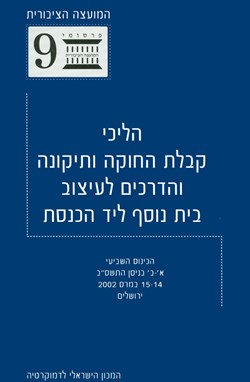Procedures for Ratifying and Amending the Constitution, and Methods to Design an Additional Knesset Chamber
The Seventh Public Council Conference, March 2002
- Publication Date:
- Cover Type: Softcover | Hebrew
- Number Of Pages: 418 Pages
- Center: Constitution by Consensus
- Price: 70 NIS
A summary of the seventh meeting of IDI's Public Council, which considered procedures for ratifying and amending the constitution, and weighed the possibility of establishing a second Knesset chamber.
This book collects the proceedings of the seventh conference of IDI's Public Council. The conference dealt with two main issues. The first was the appropriate models of procedures to adopt and amend a constitution. The full process of drafting a constitution is complex, so checks and balances and mechanisms for reaching agreement must be incorporated into the various stages of the process. One recommendation made repeatedly was that the first step in establishing a constitution should be the Knesset's passage of a Basic Law: “Drafting and Ratifying a Constitution.” This would make it clear from the outset which entities would take part in the process, as well as their composition and their powers. Agreement on the details of the process is an important step toward enacting a constitution.
The second key topic addressed by the conference was the addition of an upper house alongside the Knesset. The existence of an upper house in a government insures the decentralization of the government’s power and wisdom, two important foundational ideas of democracy. The conference conducted an in-depth examination of the idea of establishing an upper chamber. The new body would improve the functioning of the legislature and make it more efficient, in terms of both its classic duties—representation, supervision, oversight, and legislation—and its unique role of enacting and defending the constitution. An additional legislative house also has drawbacks, however, and could delay the passage of legislation because of disagreements with the lower house.
The conference discussed the main functions that the upper chambers fills in several countries, and considered three theoretical models for such a body in Israel. These models differ with regard to the roles of supervision and oversight, territorial representation, and constitutional emphasis.

